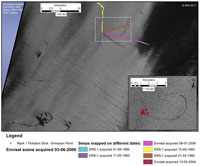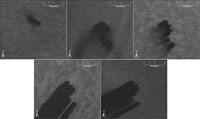The European Union's Copernicus Sentinel-1 mission is providing far more images than previous generations of synthetic aperture radar satellites, bringing many significant advantages. One of them is determining the difference between naturally-occurring and polluting oil on the ocean surface.
The European Union's Copernicus Sentinel-1 mission is providing far more images than previous generations of synthetic aperture radar satellites, bringing many significant advantages. One of them is determining the difference between naturally-occurring and polluting oil on the ocean surface.
An oil seep is a natural leak of crude oil and gas that migrates up through the seafloor and ocean depths. They are the largest source of oil entering oceans.
Seeps occur when crude oil leaks from fractures in the seafloor or rises up through sediments – similar to the way that a freshwater spring carries water to the surface. Natural seeps can lead to methane gas entering the atmosphere. When combined with the methane added to the atmosphere by anthropogenic processes, naturally seeping methane is often considered to be a negative climatic phenomenon.
However, there are other effects of hydrocarbon seepage, which are harmless or positive to the environment. The marine and lacustrine ecological system benefits from increased nutrients and increased primary production levels within the water column and seafloor. Bacterial mats and fish have been found to flourish at such sites.
It is difficult to differentiate between spilled oil and seep oil on the ocean surface, particularly when an oil spill occurs in an area with many naturally occurring seeps. However, by using Synthetic Aperture Radar (SAR), as carried on the Copernicus Sentinel-1 satellites, oil films on the surface of water can easily be seen in favourable weather conditions. By following strict rules regarding the slick shape and size, local geology, geographic setting and anthropological activity, it is possible to characterise the source of oil as natural or pollution. This technique led to the development of NPA's Global Offshore Seeps Database (GOSD).
CGG's NPA Satellite Mapping group is a world-leading supplier of satellite images, acting as an independent distributor of commercial satellite imagery and elevation data. Supported by a team of experienced petroleum geologists, GIS specialists and remote sensing professionals, NPA's offshore seepage detection technique employs satellite radar images to detect naturally-occurring oil seepage in various offshore settings, including untested offshore frontier basins. GOSD has rapidly become the industry standard with support from the majority of the world's oil companies.
As the successor to the long-running ERS and Envisat satellites (data from which already form some 90% of NPA's GOSD), Sentinel-1 enables NPA to continue to record sea surface oil slicks, with unprecedented benefits. For a similar resolution, Sentinel scenes cover an area four times larger than ERS and Envisat, so that significantly larger areas are observed in advantageous weather conditions for the formation of oil slicks, and increased temporal repetition opportunities are observed with fewer scenes.
Sentinel-1 has assisted NPA in boosting scene coverage, particularly across higher latitudes. Moreover, improvements in satellite technology and data storage allow the Sentinel satellites to provide a far higher quantity of imagery than was possible with previous generations of SAR.
Seabed oil seepage locations constantly evolve as fluid pathways migrate, although at a scale that is not readily observed by SAR satellites. The formation of new seepage locations is a rarely observed phenomenon, one which the Sentinel satellites have made more prominent.
The Copernicus Sentinel-1 satellite, with its free and open data policy, has been the only one to highlight seepage activity in the Gulf of Aden, more than 100 km from any exploration wells, where seepage slicks appear on scenes after 24 March 2016.
A survey of 19 satellite scenes over this site between September 1997 and October 2005 did not reveal any previous indication of this seepage activity.
NPA has greatly discussed possible formation events and the significance of this new discovery. Although the Gulf of Aden is a seismically active region, there have been no significant recorded earthquakes related to the observed start of seepage activity. Further investigation of other potential event triggers—such as submarine landslides, recent drilling efforts or gas hydrate disassociation within sediment—is required.
William Jeffery, Offshore Interpretation Manager at NPA Satellite Mapping, says, "With GOSD being one of our most recognised products here at NPA, we are pleased that the Copernicus Sentinel-1 products have provided us with a continuation of excellent quality data, which we believe will allow us to further develop our product over the coming years."
About the Sentinels
The Sentinels are a fleet of dedicated EU-owned satellites, designed to deliver the wealth of data and imagery that are central to Europe's Copernicus environmental programme.
In partnership with EU Member States, the European Commission leads and coordinates this programme, to improve the management of the environment, safeguarding lives every day. ESA is in charge of the space component, responsible for developing the family of Copernicus Sentinel satellites and ensuring the flow of data for the Copernicus services, while the operations of the Sentinels have been entrusted to ESA and EUMETSAT.


